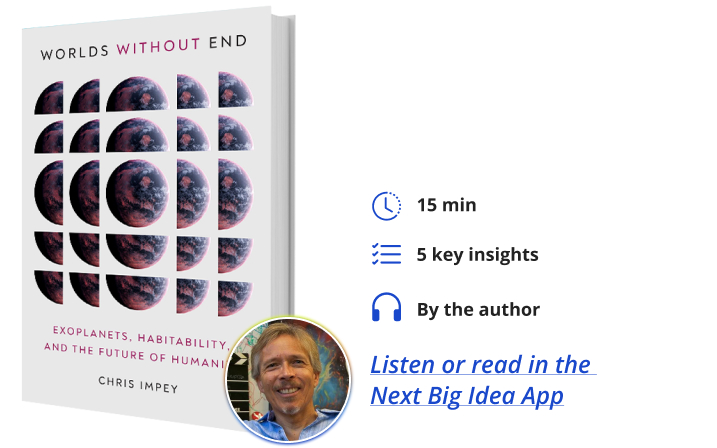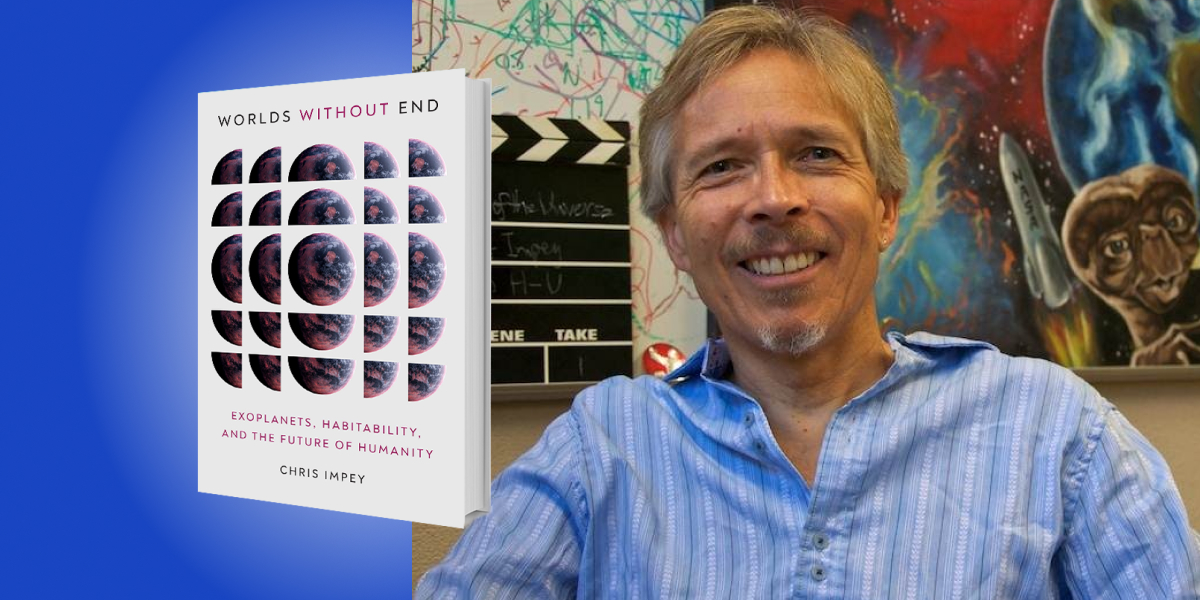Chris Impey is a Distinguished Professor in the Department of Astronomy at the University of Arizona. His work has been supported by $20 million in grants from NASA and the National Science Foundation. Impey is also a former Vice President of the American Astronomical Society. As a teacher, Impey has been named an NSF Distinguished Teaching Scholar, a Phi Beta Kappa Visiting Scholar, the Carnegie Council on Teaching’s Arizona Professor of the Year, and won the American Astronomical Society’s Career Education Award.
Below, Chris shares five key insights from his new book, Worlds Without End: Exoplanets, Habitability, and the Future of Humanity. Listen to the audio version—read by Chris himself—in the Next Big Idea App.

1. There are more planets than stars.
Take a minute to let that sink in. Astronomers had speculated that there might be planets orbiting other stars for centuries, but until 1995 none had been detected. Exoplanet hunting was a “graveyard” for astronomers since there had been many false or refuted claims over the years. Then the Swiss team of Michel Mayor and Didier Queloz found a half-Jupiter mass planet orbiting the Sun-like star 51 Pegasi every four days, for which they were awarded the 2019 Nobel Prize in Physics.
After that discovery, exoplanets have mostly been discovered by two indirect methods: the way they tug on their parent star, or the way they dim it briefly when they cross in front of it. The floodgates then opened with the launch of NASA’s Kepler spacecraft. Now, over 5,300 exoplanets are known. Hundreds are Earth-like and could host biology. The nearest is only four light-years away. Many multi-planet systems have been found, and some have architectures that are wildly different from the way the planets in our solar system are arranged. These statistics imply 20 billion habitable worlds just in our own galaxy.
Most exoplanets orbit red dwarfs, not stars like the Sun, and overall, there are more stars than planets. That means over 400 billion planets in our galaxy, and a staggering estimate of 10,000 billion billion planets in the whole universe. Many of these exoplanets have all the basic ingredients for biology: water, carbon-rich material, and a source of energy. It’s not surprising that astronomers are very confident that there’s life beyond the Earth.
2. Most planets are super-Earths.
As the number of exoplanets piles up, is the Earth the best of all possible worlds? Three hundred years ago, German polymath Gottfried Leibnitz argued that it was, and he was lampooned by the writer Voltaire for this idea in his novel Candide. Now astronomers are weighing in and it looks like there are many worlds out there that are more hospitable to life than the Earth.
“There’s evidence that super-Earths are super-habitable.”
A third of the 5,300 planets orbiting other stars are super-Earths, two to three times larger and six to eight times more massive than our planet. There’s evidence that super-Earths are super-habitable. Their thick atmospheres provide shelter for biology and their magnetic fields protect life against harmful cosmic rays. Earth is no nirvana; over the eons, the climate has veered from ocean-boiling heat to planet-wide deep freeze. The entire biosphere may have been obliterated by impacts early in Earth’s history. So, we’re lucky life made it through all these extremes. With billions of super-Earths in our galaxy, and billions of years for life to evolve on many of them even before the Earth formed, astronomers expect the galaxy could be teeming with life.
3. Orphan exoplanets are habitable and live longer than “normal planets.”
Imagine an advanced civilization on an Earth-like planet that’s sailing like an enormous spaceship through the void of intergalactic space. This is not science fiction fantasy, but a realistic scenario based on “orphan” or rogue exoplanets.
Astronomers have recently discovered exoplanets that have been ejected from their star systems. It’s not a rare scenario but a common outcome of the chaotic orbits after a solar system has just formed. By some estimates, there may be as many orphan planets as there are “normal” planets tethered by gravity to their parent star. Many will be habitable, and astronomers anticipate that many will host life. They’re hard to detect because the traditional radial velocity and transit methods don’t work when there is no parent star. Microlensing techniques are used to find them.
Most orphan planets roam the Milky Way, but some will have been ejected fast enough to escape the galaxy. Inhabitants of these planets will have interstellar and intergalactic travel for free. Life on Earth will be extinguished when the Sun dies in 5 billion years. But life on orphan planets could persist for tens of billions of years, potentially reaching an unimaginable level of complexity.
4. Messaging extraterrestrial intelligence is controversial.
We don’t yet know if there is any life in the universe beyond the Earth, and the most likely way life will first be detected is by microbes altering the chemistry of an exoplanet atmosphere. Yet a controversy is raging about sending messages to extraterrestrial civilizations.
There are tens of billions of habitable planets in the Milky Way galaxy, and it’s likely that some of them have achieved or surpassed our level of intelligence and technology. This motivates SETI, the search for extraterrestrial intelligence, which listens for artificial radio or optical messages sent our way. SETI has met with 65 years of what is called the “Great Silence.”
“Before he died, Stephen Hawking argued that we should not try to communicate with aliens since we can’t anticipate their nature and motivations.”
Undeterred, some astronomers have started doing experiments in METI, which involves messaging extraterrestrial intelligence. When it comes to aliens, listening is fine, but talking can be controversial. Before he died, Stephen Hawking argued that we should not try to communicate with aliens since we can’t anticipate their nature and motivations. Intelligent aliens could be malign and might choose to destroy us. Another concern is the small number of astronomers doing METI experiments. It’s difficult to design a universal message and in any case, nobody appointed them to “speak for Earth.” For these reasons, METI is controversial.
5. Exploring extraterrestrial biology requires imagination.
The biggest wild card in the search for life in the universe is knowing what to look for. All life on Earth—from a fungal spore to a butterfly to a blue whale—is the result of a single biological experiment that began four billion years ago. There are tens of billions of habitable worlds in the galaxy and thousands of trillions in the universe, and they all have the same chemical ingredients.
However, biology on any of these planets need not be the same as terrestrial biology. It might not use the same replicating molecule and genetic code, it might not be based on cells, and its higher levels of organization might be radically different from life forms we’re familiar with.
The problem is that astronomers are only looking for what they know. On Mars, they’ll look for nucleic acids and DNA. On exoplanets, they’ll look for microbes with metabolisms based on photosynthesis. With the search for extraterrestrial intelligence, they’re looking for specific technologies that generate radio and laser pulses. A much more advanced civilization than ours might use technologies we couldn’t even recognize. If biology is radically different elsewhere, these experiments will fail. The search for life beyond Earth might only succeed when we’ve asked and answered the question: How strange can life be?
To listen to the audio version read by author Chris Impey, download the Next Big Idea App today:
































